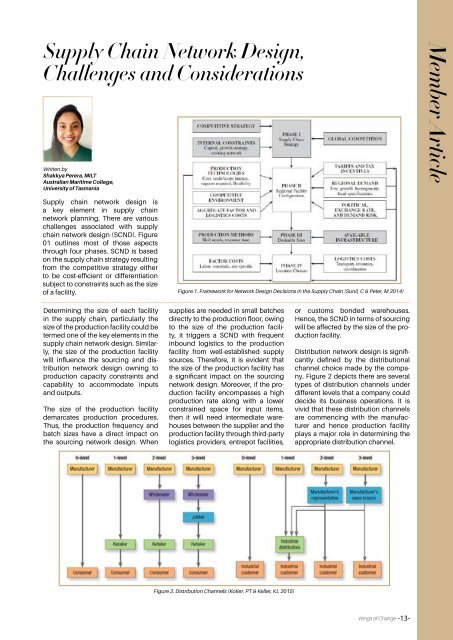Wings of Change Newsletter October 2023
The 9th edition of the newsletter from WiLAT
The 9th edition of the newsletter from WiLAT
Create successful ePaper yourself
Turn your PDF publications into a flip-book with our unique Google optimized e-Paper software.
Supply Chain Network Design,<br />
Challenges and Considerations<br />
Written by<br />
Shakkya Perera, MILT<br />
Australian Maritime College,<br />
University <strong>of</strong> Tasmania<br />
Member Article<br />
Supply chain network design is<br />
a key element in supply chain<br />
network planning. There are various<br />
challenges associated with supply<br />
chain network design (SCND). Figure<br />
01 outlines most <strong>of</strong> those aspects<br />
through four phases. SCND is based<br />
on the supply chain strategy resulting<br />
from the competitive strategy either<br />
to be cost-efficient or differentiation<br />
subject to constraints such as the size<br />
<strong>of</strong> a facility.<br />
Figure 1. Framework for Network Design Decisions in the Supply Chain (Sunil, C & Peter, M 2014)<br />
Determining the size <strong>of</strong> each facility<br />
in the supply chain, particularly the<br />
size <strong>of</strong> the production facility could be<br />
termed one <strong>of</strong> the key elements in the<br />
supply chain network design. Similarly,<br />
the size <strong>of</strong> the production facility<br />
will influence the sourcing and distribution<br />
network design owning to<br />
production capacity constraints and<br />
capability to accommodate inputs<br />
and outputs.<br />
The size <strong>of</strong> the production facility<br />
demarcates production procedures.<br />
Thus, the production frequency and<br />
batch sizes have a direct impact on<br />
the sourcing network design. When<br />
supplies are needed in small batches<br />
directly to the production floor, owing<br />
to the size <strong>of</strong> the production facility,<br />
it triggers a SCND with frequent<br />
inbound logistics to the production<br />
facility from well-established supply<br />
sources. Therefore, it is evident that<br />
the size <strong>of</strong> the production facility has<br />
a significant impact on the sourcing<br />
network design. Moreover, if the production<br />
facility encompasses a high<br />
production rate along with a lower<br />
constrained space for input items,<br />
then it will need intermediate warehouses<br />
between the supplier and the<br />
production facility through third-party<br />
logistics providers, entrepot facilities,<br />
or customs bonded warehouses.<br />
Hence, the SCND in terms <strong>of</strong> sourcing<br />
will be affected by the size <strong>of</strong> the production<br />
facility.<br />
Distribution network design is significantly<br />
defined by the distributional<br />
channel choice made by the company.<br />
Figure 2 depicts there are several<br />
types <strong>of</strong> distribution channels under<br />
different levels that a company could<br />
decide its business operations. It is<br />
vivid that these distribution channels<br />
are commencing with the manufacturer<br />
and hence production facility<br />
plays a major role in determining the<br />
appropriate distribution channel.<br />
Figure 2. Distribution Channels (Kotler, PT & Keller, KL 2015)<br />
<strong>Wings</strong> <strong>of</strong> <strong>Change</strong> -13-
















